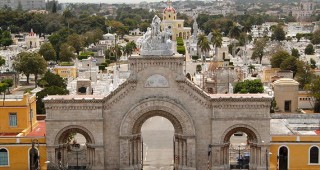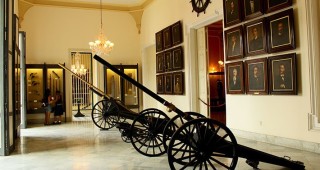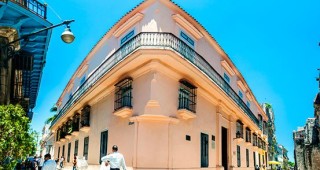This museum exhibits photos, film footage, documents, letters and personal belongings that bear witness of the 1961 literacy campaign, which eradicated illiteracy in Cuba and provided free education for everyone at all levels. Today, Cuba’s literacy rate is estimated at 96%.
Opening hours: 8am-3pm Tues-Fri; 8am-noon Sat
When Plaza de la Revolución became filled with pencils
By Victoria Alcalá
Every Cuban parent knows–because their children take care of reminding them–that December 22 is Educator’s Day, and they must juggle the family budget to bring gifts to teachers, assistants, and directors, besides contributing snacks and soft drinks for the celebration. But beyond gifts and festivities, not many remember at this point why it is a special day at every school in the country.
According to the 1953 census, the enrollment rate then was about 50 percent, the illiteracy rate was 23 percent and the average grade level completed was 3.1. In 1957, the Rebel Army in the mountains had decreed that education was central to the developmental process and that the revolution would immediately start a literacy campaign. In keeping with this sentiment, after the triumph of the Revolution on January 1, 1959, the Revolutionary Government took the necessary steps to promote public education, and as early as March of that year, the National Literacy and Basic Education Commission was created.
On August 29, 1960, at the graduation of the first group of volunteer teachers, whose mission was to make up for the deficit of teachers in the country, especially in rural areas, Fidel Castro said: “Next year we have to establish ourselves a goal: to eradicate illiteracy in our country.” And less than a month later on September 26, at the United Nations, he announced a literacy campaign in Cuba which would eradicate illiteracy in less than a year. On December 31, 1960, when Fidel and those same volunteer teachers were waiting for the arrival of the New Year, they decided to baptize 1961 as “Year of Education.
Castro was a dreamer, but not the only one. On January 23, 1961, when the Literacy Campaign had just begun, in the graduation ceremony of the second group of volunteer teachers, the then Cuban Prime Minister reported that members of a counterrevolutionary band had killed the young volunteer teacher Conrado Benítez. A few months later, the Revolution developed a program of individual teaching by alfabetizadores. Organized in the Conrado Benítez Brigade, 105,664 students (54,953 girls and 50,711 boys) went to every corner in Cuba to teach how to read and write to their fellow countrymen and women. Each “brigadista” received an equipment package that included two uniforms, two pairs of socks, a pair of boots, a belt, an olive green beret, a backpack, a hammock, a shoulder patch of Conrado Benitez, the primer and the teacher’s manual, a lantern and 10 pesos for personal expenses. Educators from Argentina, Uruguay, Panama, Venezuela, Chile, Costa Rica, Brazil, Guatemala and the United States, among other countries, also participated in the campaign.
Fifty-two years later, this is easily told, but the youth who went to the countryside to teach faced many difficulties, from family opposition, especially the girls, to the logical problems of adapting to an unknown environment. The average age of these voluntary literacy workers was fourteen to sixteen and almost three-quarters of them came from urban homes.
In an interview, actress Mireya Chapman from Holguín said that she had to argue with her mother, who strongly objected to her going away from home. “She told me that young girls couldn’t leave their homes, let alone go into the mountains and live with the peasants,” Mireya revealed. “When my father came from work, I spoke with him aside and he said to my mother: ‘You’d better let her look out for herself. Why can’t she go and teach if all the young people are doing so?’”
Even today, when the participants of that utopia meet, anecdotes come to the surface–falling from hammocks; stampedes caused by the presence of a frog or a majá (the harmless Cuban snake); having to ride a horse for the first time; terror caused by ghost stories, which are so common in the Cuban countryside, and so on.
On June 18, 1961, the effort began to show its results with the first graduation of around 3,500 people in Havana who had been taught to read and write. One woman told the press, “I will never have to sign with my thumbprint again. Now I will always sign like this: María Cruz.”
The alfabetizadora Sonia Labrada wrote in her diary: “May 16…I bathed early, we ate and soon Romilio arrived. Then Manolo with his wife and their kids. He’s on letter “P.” I gave her some numbers to add and subtract, and a short dictation. She can already read and write quite well. They left after 9 and shortly we all went to bed.”
Some stories are filled with moving altruism and solidarity. For example, the then Minister of Education, Armando Hart, taught the woman who since then and to this day has been his faithful secretary to read and write.
Teachers and students established a solid friendship, and in some cases lifelong bonds. I have a friend who brought to her home in Havana a childless couple who she taught to read and write in the eastern provinces. She and her husband built them a small house in their yard, and there they stayed forever. My friend’s children had not four but six grandparents.
The success of the literacy campaign was possible because involved the vast majority of Cubans in a noble purpose. The professional supervising teachers and the Conrado Benítez Brigade, the latter made up of students mostly from the cities, were joined by the People’s Teachers (Alfabetizadores Populares) and the Patria o Muerte Worker Brigade. The light of knowledge, which since then is symbolized by the lanterns that the voluntary teachers carried to provide light for lessons in the evenings, began to shine in every home in Cuba. All obstacles were overcome. Illiterates, mostly older people, who at first had refused to learn, were drawn in. People in very remote regions also had their teachers. Conditions were ensured for fishermen, sailors, chauffeurs and workers with irregular shifts to learn to read and write. Patients of lengthy hospitalization, such as TB and leprosy sufferers, as well as prison inmates also had someone to teach them, overcoming qualms, fears and prejudices.
When the Campaign ended, 707,212 Cubans had been alphabetized and the level of illiteracy was reduced to 3.9% (25,000 people–Haitians who hardly spoke any Spanish, physically and mentally disabled persons, elderly people and patients in very poor health–were found unable to learn to read and write). This illiteracy rate placed Cuba among countries with the lowest illiteracy rates in the world.
As the last day in December approached, territory after territory was declared free of illiteracy. The first one was Melena del Sur, which on November 5, 1961, was declared by Fidel as the “first territory free from illiteracy.” On December 22, the entire island was declared free from illiteracy. A jubilant young Castro said at Plaza de la Revolución: “No time is more solemn and moving, no instant more joyous, no minute filled with more genuine pride and glory than this one in which four and a half centuries of ignorance have been demolished,” as hundreds of thousands of literacy teachers who had just arrived from all over Cuba waved huge pencils in one hand and held the symbolic lantern in the other, as trophies of an unprecedented battle that is commemorated each year in every Cuban school.



 Eclectic
Eclectic







